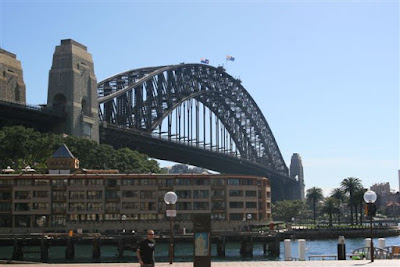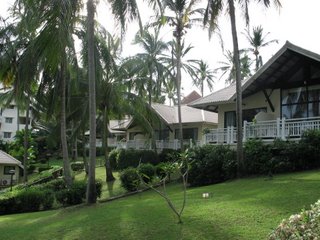This unique and diverse marine ecosystem comprises about 2900 reefs, 600 continental islands and 300 coral cays. Only six percent of the Great Barrier Reef Marine Park consists of coral reefs however. The rest is made up of sea grass, mangroves, sand, algal and sponge gardens, interreefal communities and other habitats.
It is home to approximately 1500 species of fish, 360 species of hard coral, one third of the world's soft corals, 5000 - 8000 species of molluscs, 400 - 500 species of marine algae, 600 species of echinoderm, 17 species of sea snakes, 22 species of seabirds and 32 species shorebirds that live and breed on the islands, 13000 dugong, 6 species of marine turtles and 30 species of whales and dolphins.
The Reef was inscribed on the World Heritage List on 26th October 1981.

Port Douglas is one of the closest departure points to the outer reef but it is still a 2 hour trip out there by boat. We chose Wavelength Charters because they cater only for snorkelers, take a maximum of 30 people, have a comfortable boat and have sole access to some better parts eg. Opal Reef. We took our seasick tablets the night before and I was glad we did. We sailed into a 1-2m swell and a 20 knot wind. It was a little bumpy until we got into the protected area behind the reef. Some others who had waited until departure to take medication were quite ill during the journey.

We were provided with our wet suits, mask, snorkel and flippers and then had a very detailed safety briefing. When you are alone 40km off the coast on the edge of the continental shelf you tend to listen to that quite carefully. Then it was into the warm 27deg C water for our first look at what was a few metres underneath.
What can I say but WOW!
This was the first of three different spots they took us to with each one being better and different than the last. We had about an hour at each spot to float about and look at the coral and the thousands of brightly coloured fish.



After each 'dive' and we were back on board, there was a roll call and count. They didn't want to leave anyone behind.
It has happened!!!!! But not with Wavelength
We continued to explore after a great lunch during which a marine biologist, Chris, (he took the reef pics on this blog) gave us a talk about the formation of the reef, what to look for as far the the different kind of corals are concerned and most alarmingly how short a time it may be around. Global warming and ocean pollution is killing the coral at a fast rate. Some estimate it may be with us only for 20 more years or so.
The colour of the water around the reef is an amazing azure blue and is so clear. The deeper parts are a dark luminous blue. It was a bit daunting to think that where we were swimming was only a few metres deep but just over the reef on the eastern side it plunged to 1000m.
At the last spot known as SNO we were warned to keep an eye out for a huge Maori Wrasse who is a regular visitor when the boat anchors here. And on cue he turned up and swam amongst us.



There was a very steep drop off between the boat and the reef at this point. It was suggested that this may be a good spot to see some reef sharks. I floated around there for about 10 minutes but saw none. They are night hunters and usually shy. Unfortunately we didn't see any turtles either.
All too soon the adventure was over. There is little doubt about the reef's status as one of the Seven Natural Wonders of the World. It was another bumpy ride back to port but at least this time we had a following swell.
That evening we celebrated our day with a great Italian seafood meal at 'Bucci'.
The following morning we headed north towards Cape Tribulation in the Daintree rainforest. This is a far north as you can go on the east coast of Australia without a 4WD.
Our first stop was the Daintree River ferry.


From the sign above obviously I was not going too close to the river bank to take pictures. Numerous companies run croc sighting tours up and down the river. We travelled along the scenic winding road enclosed by thick jungle. There are plenty of places to stop and enjoy some very panoramic views of the area.

We took a short detour down to Cow Bay and had a pleasant walk along a deserted beach followed by a sampling of ice cream made from exotic fruit grown locally such as black sapote, soursop, wattle seed, coconut, macadamia, mango and jackfruit.

At Cape Tribulation we travelled for a few hundred meters up the 4WD track that leads 100km to Cooktown and ultimately another 1000 km to "the tip" or Cape York, the most northerly point of Australia. It was already rough for that short distance.
"Cape Trib" is a very popular tourist destination and was pretty crowded as it has one of the best beaches in the area.

The 1200 sq.km Daintree Rainforest contains 30% of frog, marsupial and reptile species in Australia, and 65% of Australia's bat and butterfly species and 18% of bird species in the country can be found in this area. There are also over 12000 species of insects. All of this diversity is contained within an area that takes up only 0.2% of the landmass of Australia. The Daintree is over one hundred and thirty-five million years old making it the oldest in the world.
It certainly is an impressive area to visit.

All too soon our trip north was over and we headed back to Sydney for a last night on the town.
A few drinks at the Opera House Bar and dinner at the Ice Bar on Circular Quay and then a really decadent dessert the Guylian Belgian Chocolate Cafe.
Next morning we took our visitors back to the airport for their 24 hour journey home.
We had all had fun and I think they now had a reasonably good idea about the Australian way of life and how scenically diverse the country is.
It was good to have them both here.
And to end, some classic statements made by the 'tour group' during the two weeks. Of course only we four know who said them and the context in which they were said.
"where is the freakin' steering wheel?"
"BIG orange tabby"
"as big as this table"
"back off, bitch!"
"I thought I ordered a pork rib"





































































